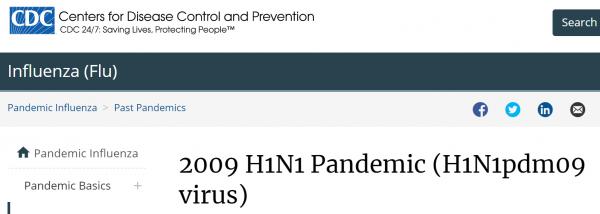| 春瑩津津樂道美國09年流感死亡率17.4%! |
| 送交者: Pascal 2020年02月12日02:45:44 於 [五 味 齋] 發送悄悄話 |
|
CDC: 12,469 / 60,800,000 = 0.0205% 春瑩:10,579,200 / 60,800,000 = 17.4%
*******************************
視頻鏈接: https://twitter.com/chuaijiji/status/1227392733624451072
***************************
Isolation of a new bat virus in a study published in the Journal of Virology on Dec. 30, 2015, titled “Isolation and Characterization of a Novel Bat Coronavirus Closely Related to the Direct Progenitor of Severe Acute Respiratory Syndrome Coronavirus,” found that the virus, named SL-CoV-WIV1, was almost identical to Rs3367 with 99.9% genome sequence identity. The researchers identified that WIV1 can use human ACE2 as an entry receptor and has the potential to infect human cells in this study. Subsequently, the same research group isolated another bat virus that can use ACE2 and infect human cell lines in the lab in 2015. In addition, Dr. Shi’s group conducted another study in 2018 to address the question of whether some bat viruses can infect humans via using human ACE2, without the need of an intermediate host. But to the date of their study, “no direct transmission of SARS-Like CoVs from bats to people has been reported”. 2015年12月30日發表在《病毒學雜誌》上的一項研究中,名為「與嚴重急性呼吸系統綜合症冠狀病毒直接源細胞密切相關的新型蝙蝠冠狀病毒的分離和鑑定」的研究發現了一種新的病毒,名為SL-CoV-WIV1,其基因與Rs3367幾乎相同,具有99.9%的基因組序列相似性。研究人員確定,WIV1可以使用人類ACE2作為進入受體,並有可能感染人類細胞。隨後,同一研究小組於2015年在實驗室中分離出了另一種可以使用ACE2並感染人類細胞系的蝙蝠病毒。 此外,石博士的小組於2018年進行了另一項研究,以解決一些蝙蝠病毒是否可以通過使用人ACE2感染人類而無需中間宿主的問題。但是到迄今他們的研究,「尚未有類似SARS的冠狀病毒可以從蝙蝠直接傳給人類的報導」。 Zhengli Shi’s group at the Institute of Virology at Wuhan was successful in isolating two infectious clones of bat SARS-Like CoV: SL-CoV-WIV1 and WIV16 from bats. In their further studies, they found out that these SL-CoV Spike protein (S protein) “[were] unable to use any of the three ACE2 molecules as its receptor; Second, the SL-CoV failed to enter cells expressing the bat ACE2; Third, the chimeric S covering the previously defined receptor-binding domain gained its ability to enter cells via human ACE2, albeit with different efficiencies for different constructs; Fourth, a minimal insert region ( Amino acids 310 to 518 ) was found to be sufficient to convert the SL-CoV S from non-ACE2 binding to human ACE2 binding.” Therefore, Shi’s group found in a study published in the Journal of Virology in February 2008 that the natural bat coronavirus cannot use the human ACE2 receptor to infect humans. However, when inserted with some amino acids from position 310 to 518 for the bat CoV S protein sequence, the chimeric bat CoV can use the human ACE2 receptor. Meanwhile, another research group led by Dr. Li published their finding in 2013 that 5 amino acid sites on CoV spike proteins are crucial in making the binding to human ACE2 on SARS virus (those positions are Y442, L472, N479, D480, T487). These 5 sites just lie in the region that the Shi group noted to be important above. Later, Li and Shi jointly conducted a gain-of-function study published in the Journal of Virology in September 2015 on the MERS virus and a bat virus (strain HKU4) in 2015. Since MERS virus can enter human cells but HKU4 can not, they introduced 2 single mutations in the HKU4 spike protein and found that the new mutant S protein can enable HKU4 to enter human cells. If they mutated 2 sites in MERS spike, the resulting MERS pseudovirus (experimental virus) cannot enter human cells anymore. 武漢市病毒研究所的石正麗研究小組成功地從蝙蝠中分離出兩個蝙蝠SARS樣冠狀病毒的傳染性克隆:SL-CoV-WIV1和WIV16。在進一步的研究中,他們發現這些SL-CoV 突觸蛋白(S蛋白)「無法使用三種ACE2分子中的任何一種作為其受體。其次,SL-CoV無法進入表達蝙蝠ACE2分子的細胞中。第三,覆蓋先前定義的受體結合域的嵌合體S蛋白通過人類ACE2分子獲得了進入細胞的能力,儘管對不同構建體的效率不同。第四,發現最小的插入區(氨基酸310至518)足以將SL-CoV S蛋白從非ACE2分子結合轉化與人類ACE2分子結合。」 因此,石的小組在2008年2月發表在《病毒學雜誌》上的一項研究中發現,天然蝙蝠冠狀病毒無法利用人類ACE2受體來感染人類。但是,當在蝙蝠CoV S蛋白序列310到518的位置插入一些氨基酸時,嵌合體蝙蝠CoV可以使用人類ACE2受體。 同時,由李博士領導的另一個研究小組於2013年發表了他們的發現,冠狀病毒突觸蛋白上的5個氨基酸位點對SARS病毒與人類ACE2的結合至關重要(位置分別為Y442,L472 ,N479,D480,T487) 。這五個點就在石小組在上面指出的重要區域內。 後來,李和石於2015年9月在《病毒學雜誌》上聯合發表了項「功能獲得」的研究。該研究於2015年針對MERS病毒和一種蝙蝠病毒(HKU4株)進行了研究。他們在HKU4突觸蛋白中引入了2個單突變,發現新的突變S蛋白可以使HKU4進入人體細胞。如果他們在MERS S蛋白突變2個位點,則產生的MERS偽病毒(實驗病毒)將無法再進入人類細胞。 To their surprise, the chimeric virus (SHC014-MA15) can use SHC014 spike to bind to human ACE2 receptor and enter human cells. SHC014-MA15 can also cause disease in mice and cause death as well. Existing vaccines to SARS cannot protect animals from SHC014-MA15 infection. Therefore, these chimeric virus studies can lead to the generation of more pathogenic, more deadly CoV strains in mammalian models. Due to the U.S. government-mandated pause on the gain-of-function (GOF) studies, this international research did not proceed further at that time. However, there is no evidence that Shi’s group in China stopped any further study on the track of introducing GOF mutations on the CoV. And it is clear that Shi’s group already mastered the reverse-engineering technology that is sufficient to introduce mutation in current SARS-CoV or SARS-Like CoV to create mutant infectious coronavirus. 令他們驚訝的是,嵌合病毒(SHC014-MA15)可以使用SHC014突觸結合人類ACE2受體並進入人的細胞。 SHC014-MA15也可引起小鼠疾病並引起死亡。現有的SARS疫苗不能保護動物免受SHC014-MA15感染。因此,這些嵌合病毒研究可導致在哺乳動物模型中產生更致病,且更致命的冠狀病毒株。 由於美國政府強制暫停「功能獲得」(GOF)研究,因此該國際研究當時並未進一步進行。但是,沒有證據顯示石博士在中國的小組停止了在CoV中引入GOF突變的進一步研究。很明顯,石的研究小組已經掌握了逆向工程技術,該技術足以在當前的SARS冠狀病毒或SARS 樣冠狀病毒中引入突變以產生突變型的傳染性冠狀病毒。
t has been two months since the outbreak of the coronavirus in Wuhan and its spread has shown no signs of slowing down in China. More than 35 Chinese cities have been put on lockdown by Chinese authorities in an attempt to isolate confirmed and suspected cases. The lives of millions of people are in danger as the virus shows signs of spreading further in China as well as internationally. There are significant gaps in the official investigations into the origins of the novel Coronavirus. In order to contain the virus, one first needs to understand how a virus that allegedly originated in animals found its way to humans. For this to happen, the Chinese authorities need to release their animal testing data and samples. Testing results from animal samples collected at epicenters would give important insights into what animals might serve as intermediate hosts for the new coronavirus. This is critical to the containment of the epidemic. For example, if rats are the intermediate hosts for this virus, it would be futile to shut down the cities to restrict people’s movements while infected rats are still moving freely. Results from animal samples could also guide policy decisions that would reduce the risk of another outbreak. An Animal Origin of the VirusScientific studies based on phylogenetic analysis have researched the sequence of the novel coronavirus, compared it to other coronavirus sequences, and found it likely originated in bats. Researchers from the Wuhan Institute of Virology found the genome in the virus found in patients was 96 percent identical to that of an existing bat coronavirus, according to a study published in the journal Nature. But there have been other theories as well. One Chinese study suggested, for example, that snakes were the source of transmission to humans. However, many scientists believe that reptiles are a less likely source and that mammals like rats and pigs, and some birds, have been the primary reservoir for coronaviruses. With this in mind, phylogenetic studies of viral genome sequences need to be supported by animal studies to confirm the origin of the infection, as well as to determine whether there is an intermediate host. It is not an easy task for a virus to establish zoonotic transmission, and coronaviruses rarely leap from animal to human infection with high transmissibility. There is even less chance to see a coronavirus leap directly from bats to humans. To infect new hosts, mutations need to occur with the viral surface proteins and/or envelope and structural genes, so that the mutated viruses can bind and enter the cells of new species, and efficiently complete the replication cycles in the new hosts. Some scientists have argued that coronaviruses can jump directly to humans, without mutating or passing through an intermediate species. However, an intermediate host was clearly needed to establish zoonotic transmission to humans in the previous outbreaks of coronaviruses. Many studies suggested that the bat coronavirus jumped from its natural host bats to civets and then to humans during the 2003 SARS outbreak, and it jumped from bats to camels and then to humans for the MERS outbreak. So, civets and camels would serve as intermediate hosts for zoonotic transmission. Because bats were not sold at the Huanan market in Wuhan—the epicenter of the infection—at the time of the outbreak, this suggests the existence of another intermediate animal host that may have transferred the virus to humans. What is the most puzzling is that there have been no reports on the testing of animal samples collected in any epicenters in Wuhan, especially at the Huanan seafood market, to identify what animals might be the host or intermediate hosts of this novel Wuhan coronavirus. Chinese scientists published a report in Lancet recently which stated that “the majority of the earliest cases included reported exposure to the Huanan Seafood Wholesale Market” and that patients could have been infected through zoonotic or environmental exposures. Another report on Lancet by Chinese CDC scientists claimed that “on the basis of current data, it seems likely that the 2019-nCoV causing the Wuhan outbreak might also be initially hosted by bats, and might have been transmitted to humans via currently unknown wild animal(s) sold at the Huanan seafood market.” However, so far, no information was released about the amount, and species, of wild animals present at the Huanan seafood market upon closure; nor about how the animals were managed or disposed of when the market was closed on Jan. 1, 2020. And no information was released about how many animal samples were tested for SARS-CoV or Wuhan Coronavirus via viral nucleic acid testing methods. Official Chinese state news agency Xinhua reported on Jan. 26 that 33 samples out of 585 environmental samples collected at the Huanan Seafood market were positive for nucleic acids from new Coronavirus, suggesting the virus originated from wild animals or stocks sold there. However, these samples were from the environment—not from animals. It would be an ultimate failure of the Wuhan public health commission and Chinese CDC if no animal samples were collected and tested prior to, or at the time of, the shutting-down of the Huanan seafood market, where many animals were sold at the time of the outbreak. It would be similar to conducting an investigation on a food-borne disease outbreak without taking restaurant food samples related to the outbreak, and instead taking dining table surface swabs to test. Background of the Huanan Seafood Market ClosureThe 2019-nCoV has caused rapid infection in China and spread to other countries outside China, which has led to a global health crisis. The Huanan seafood market is known to be a major outlet for the collection and distribution of live and dead wild animals. These included live wolves, hedgehogs, deer, birds, snakes, goats, hares, and boars that were sold and available in the east section of the seafood market. A Wuhan medical and health committee identified multiple pneumonia cases associated with Huanan seafood market, which were announced on Dec. 31, 2019. The seafood market was closed by the Wuhan government on Jan. 1. Chinese medical reporters visited the market on Dec. 31, 2019, the evening before its closure on Jan.1 where they observed poor hygiene, and wild animal bodies and organs disposed of in an unorganized manner. This suggested that a relatively large quantity of wild animals were still present at the market upon the forced closure. No Information on Wild Animals at the Seafood Market Was DisclosedYet, no information was released about the amount, and species, of animals present upon closure, how many animals were tested for Coronavirus, and how the animals were managed or disposed of upon the closure of the market on Jan. 1. A Chinese media outlet, Yicai, inquired about the outcome of the wild animals sold at the market and confirmed that there was no disclosure from the Wuhan government. Dr. Guan Yi, the current director (China affairs) of the State Key Laboratory for Emerging Infectious Diseases at the University of Hong Kong, visited Wuhan on Jan. 21 with the goal of identifying the animal source. He mentioned in a media interview that locals refused to cooperate with him. He pointed out that with the market now closed, it would be difficult to investigate the origin of the virus. He said the “Huanan seafood market was cleaned after the closure, ‘the crime scene’ was gone, and how can you solve a case without evidence?” Gao Fu, director of the Chinese Center for Disease Control and Prevention stated, “it is clear that the source of infection was from wild animals, but we don’t know which species due to closure of the seafood market.” The Huge Risks of Not Identifying the Original or Intermediate Animal HostsThe U.S. Center for Disease Control (CDC) stated that “much is unknown about how 2019-nCoV, a new coronavirus, spreads.” So far the understanding is that the major pathway of 2019-nCoV infection is respiratory droplet transmission and contact from humans to humans. Guan Yi and Kwok-yung Yuen of the University of Hong Kong (HKU) et. al. identified severe acute respiratory syndrome coronavirus (SARS-CoV) from caged palm civets from live animal markets in China in 2003. Their studies lead to the subsequent ban on selling civets and the closing of all wild animal markets in Guangdong and helped to confine the SARS epidemic. Typically, if an animal is identified as host or source of spread of disease, authorities and the CDC would initiate prevention and control measures such as an awareness campaign, proper quarantine of sick animals and disposal of carcasses as well as monitoring the potential route for how the disease spread zoonotically. Rodents are known to infest seafood markets. For example, tens of thousands of rodents are expected to be unleashed in Japan as one big fish market is closed. Huanan seafood market is also infested by rodents. If rodents were elucidated as being a potential host for coronavirus, the risk of rats infesting beyond the current quarantine zone still persists. Given the fact that coronavirus was detected from feces from patients from Shenzhen and that bat SARS-like virus strains were isolated from bat feces, the possible fecal-oral route of 2019-nCoV transmission in addition to respiratory droplet transmission would lead to a reasonable warning for people to avoid contact with animals like rats. Thus, if rodents are indeed a source or host of the 2019-NCoV infection, then, rodent contamination of food or water is a potential way for the disease to spread, which needs to be brought to the awareness of the international community. Similarly, if birds or other species were the hosts of 2019-nCoV in the seafood market, the information pertaining to the species, amount, virus type, biological reactions, and potential routes of spreading of the virus also need to be identified or reported to the world so that appropriate prevention measures could be taken. It would be serious incompetence and malfeasance if Chinese authorities did not attempt to collect nasal, fecal, and blood samples from animals and birds sold at the seafood market. Testing animal samples would reveal very important information regarding the zoonotic transmission routes, the trends of viral mutations in this outbreak, and the loopholes in the current countermeasures. Were There Other Epicenters Besides the Huanan Seafood Market?The Chinese CDC did release data from environmental samples from the seafood market and suggested that “it is originated from wild animals with species uncertain.”
The Possibility 2019-nCoV Originated From Bat SARS-Like Virus (Bat-SL-CoV)One recent Lancet report on Jan. 29, 2020, titled “Genomic characterisation and epidemiology of 2019 novel coronavirus: implications for virus origins and receptor binding,” stated that “A Blast search of the complete genomes of 2019-nCoV revealed that the most closely related viruses available on GenBank were bat-SL-CoV-ZC45 (sequence identity 87.99%; query coverage 99%) and another SARS-like betacoronavirus of bat origin, bat-SL-CoV-ZXC21 (accession number MG772934;23 87.23%;” “Notably, the 2019-nCoV strains were less genetically similar to SARS-CoV (about 79%) and MERS-CoV (about 50%).” This message might be interpreted as 2019-nCoV being biologically closer related to SARS-like betacoronavirus of Bat origin and bats may be the original host of this virus. However, the authors did not claim that the only host to 2019-nCoV is a bat.
They mentioned that most bats in Wuhan are hibernating and no bats are sold at the Huanan seafood market. Thus, the chance of physical contact from bats to spread the virus to humans or animals at Wuhan is highly unlikely. Studies From Wuhan Institute of Virology on Bat SARS-Like CoV.Zheng-Li Shi and several other researchers at the Wuhan Institute of Virology published an article in Nature in 2013 titled “Isolation and characterization of a bat SARS-like coronavirus that uses the ACE2 receptor.” In that study, their team harvested from anal swabs or fecal samples from bats and found 2 strains of sequences from Bat SARS-Like CoV that termed as RsSHC014 and Rs3367. They process 95% nucleotide sequence identity with human SARS-CoV Tor2 strain. Isolation of a new bat virus in a study published in the Journal of Virology on Dec. 30, 2015, titled “Isolation and Characterization of a Novel Bat Coronavirus Closely Related to the Direct Progenitor of Severe Acute Respiratory Syndrome Coronavirus,” found that the virus, named SL-CoV-WIV1, was almost identical to Rs3367 with 99.9% genome sequence identity. The researchers identified that WIV1 can use human ACE2 as an entry receptor and has the potential to infect human cells in this study. Subsequently, the same research group isolated another bat virus that can use ACE2 and infect human cell lines in the lab in 2015. In addition, Dr. Shi’s group conducted another study in 2018 to address the question of whether some bat viruses can infect humans via using human ACE2, without the need of an intermediate host. But to the date of their study, “no direct transmission of SARS-Like CoVs from bats to people has been reported”. They collected serum from 218 residents who live close to bat caves with bats carrying the viruses. Those caves were the places where the Shi group collected the virus samples. Then ELISA assays were conducted to detect antibodies to bat SARS-CoV, since antibody existence would suggest a prior exposure to the bat coronavirus. They found that only 6 out of 218 (2.7 %) subjects showed seropositivity, which suggested likely infections to bat SARS-CoVs or related viruses. No clinical symptoms have been manifested in the 6 positive persons in the past 12 months. As a control, they collected 240 samples from random blood donors in Wuhan, 1000 km away from Yunnan, none of the Wuhan blood samples showed any positivity to bat SARS-like CoV. This data suggests that the chance of bat virus infecting humans is very low, <2.9% if possible, and with no obvious symptoms in human beings that live very close to the bat caves. No infection from a bat to a human has been reported in Wuhan as of 2018.
Track Record of Wuhan Institute of Virology on Engineering ‘Gain-of-Function’ Bat SARS-Like CoV.Therefore, Shi’s group found in a study published in the Journal of Virology in February 2008 that the natural bat coronavirus cannot use the human ACE2 receptor to infect humans. However, when inserted with some amino acids from position 310 to 518 for the bat CoV S protein sequence, the chimeric bat CoV can use the human ACE2 receptor. Meanwhile, another research group led by Dr. Li published their finding in 2013 that 5 amino acid sites on CoV spike proteins are crucial in making the binding to human ACE2 on SARS virus (those positions are Y442, L472, N479, D480, T487). These 5 sites just lie in the region that the Shi group noted to be important above. Later, Li and Shi jointly conducted a gain-of-function study published in the Journal of Virology in September 2015 on the MERS virus and a bat virus (strain HKU4) in 2015. Since MERS virus can enter human cells but HKU4 can not, they introduced 2 single mutations in the HKU4 spike protein and found that the new mutant S protein can enable HKU4 to enter human cells. If they mutated 2 sites in MERS spike, the resulting MERS pseudovirus (experimental virus) cannot enter human cells anymore. Furthermore, Shi’s group joined an international group to generate a chimeric virus with the bat virus SHC014 they harvested in Yunnan. Since they know SHC014 is unlikely to bind to human ACE2, they “synthesized the SHC014 spike in the context of the replication competent, mouse-adapted SARS-CoV backbone”. So, that is a lab-engineered virus with SARS-CoV Mouse adapted backbone (MA15) but with SHC014 spike. To their surprise, the chimeric virus (SHC014-MA15) can use SHC014 spike to bind to human ACE2 receptor and enter human cells. SHC014-MA15 can also cause disease in mice and cause death as well. Existing vaccines to SARS cannot protect animals from SHC014-MA15 infection. Therefore, these chimeric virus studies can lead to the generation of more pathogenic, more deadly CoV strains in mammalian models. Due to the U.S. government-mandated pause on the gain-of-function (GOF) studies, this international research did not proceed further at that time. However, there is no evidence that Shi’s group in China stopped any further study on the track of introducing GOF mutations on the CoV. And it is clear that Shi’s group already mastered the reverse-engineering technology that is sufficient to introduce mutation in current SARS-CoV or SARS-Like CoV to create mutant infectious coronavirus.
Interestingly, Shi’s group published on bioRxiv on Jan. 23, 2020 that a new bat coronavirus that they detected in Yunnan, named BatCov RaTG13, shares 96.2 percent overall genome sequence identity with 2019-nCoV. However, this virus was never mentioned or published in their research before. In the sequence information provided by them in the supplemental material and method section, 3 sequences are shared between the 2019-nCoV they collected and the RATG13 virus but not in any of the other SARS or Bat SARS-Like CoV families in the paper listed. The 3 sequences are located close to N terminus of the spike protein, they are GTNGTKR, NNKSWM, RSYLTPGD. Possibilities of an Animal Host of 2019-nCoV at Huanan Seafood MarketOne recent Lancet paper titled “Genomic characterisation and epidemiology of 2019 novel coronavirus: implications for virus origins and receptor binding,” reported that “as a typical RNA virus, the average evolutionary rate for coronaviruses is roughly 10⁴ nucleotide substitutions per site per year, with mutations arising during every replication cycle. It is, therefore, striking that the sequences of 2019-nCoV from different patients described here were almost identical, with greater than 99.9% sequence identity. This finding suggests that 2019-nCoV originated from one source within a very short period and was detected relatively rapidly.” With mutations in every cycle, it is highly unlikely for different bats to host viruses with the same sequence. If bats alone are not enough for virus transmission, another animal is needed as the intermediate host, and the chance of the virus being identical is even slimmer. Since the seafood market is not the only source for the outbreak, it is reasonable to postulate that if another animal is the intermediate host for the virus, that animal needs to have contact with bats, allow bat coronavirus to proliferate in them, and, eventually, the animal needs to have the capacity to transmit viruses to human beings who may or may not have contact with the Huanan seafood market. Therefore, there have been serious questions on whether this Wuhan coronavirus outbreak was due to a leak or mishandling of laboratory animals used in coronavirus studies. This is a reasonable public inquiry regarding the source of the outbreak and it warrants a transparent investigation from the Chinese authorities and foreign disease control and laboratory operation experts. This is not just about the accountability of medical ethics or laboratory safety operations, it is directly related to the current endeavors to contain the virus outbreak. While the animal host of 2019-nCoV is yet to be identified, the data and information from possible animal hosts and potential zoonic infection is imperative for prevention and controlling disease on an international scale. The Huanan seafood market has a high potential of harboring the animal host. Animal data and profiling results from the Huanan seafood market need to be disclosed immediately by Chinese authorities even if they are negative results. It is imperative for U.S. CDC and WHO officers to demand that Chinese authorities release the information about animal testing data. If Chinese authorities refuse to disclose testing data for animal samples, it could imply an intentional cover-up of the true origin of the 2019-nCoV outbreak.
https://spark.adobe.com/page/mKbM29QGon7kZ/ 來源:ZeroHedge,February 9, 2020 作者:XIANG ZHANG via The Epoch Times 新聞翻譯:TCC, ignoreme, Roberts 評論:TCC 在短短兩個多月的時間,武漢冠狀病毒已經引起了中國三、四十個城市封城,世衛組織宣布為全球緊急事件,多國取消與中共航班等等,其影響不僅在公共衛生上,也對全球經濟正帶來未知的後果。 以流行病學及病毒學來說,病毒的起源以及可能宿主的掌握,對於流行病的控制是非常關鍵的。例如,如果老鼠是該病毒的中間宿主,那麼在受感染的老鼠仍在自由活動的情況下,關閉城市以限制人們的行動是徒勞無功的。 疫情爆發已經兩個月了,這個全球關注的起源問題,迄今撲朔迷離,眾說紛紜。在這篇報導中,引用了多篇的學術論文與報告,從分子測序到蛋白分析比對,來找尋這病毒的源頭。 蝙蝠與華南海鮮市場 病毒要建立人畜相傳的傳播並不是一件容易的事。基於演化史分析的報導,雖然此病毒基因序列與蝙蝠的冠狀病毒非常相似,但一般冠狀病毒很少會以高傳播率從動物傳播到人類的。並且蝙蝠冠狀病毒直接跳傳到人類的機會更渺小,尤其是武漢的大部分蝙蝠正在冬眠,且華南海鮮市場不賣蝙蝠。根據研究SARS(果子狸))與MERS(駱駝)的中間宿主所得的經驗, 科學家又猜想是否這新病毒也有中間宿主?在一月一日華南海鮮市場關閉後,疑雲重重,中共一直未提出動物採樣的結果來進行分析討論。關閉後,華南海鮮市場被打掃乾淨,’犯罪現場’消失了,如何在沒有證據的情況下解決一個案件呢? 武漢病毒研究所與SARS樣冠狀病毒的研究 武漢新型冠狀病毒在結構上帶有非常重要的觸突蛋白(S蛋白),據研究其結構與人類的血管緊張素轉化酶2(ACE2)完全相同,可與人的細胞表面的ACE2受體結合,進而感染人類細胞。武漢病毒學研究所早在2013年《自然》雜誌上發表的一篇文章,題為“使用ACE2受體的蝙蝠SARS樣冠狀病毒的分離和鑑定“。更巧的是,該研究室主要領導人石正麗是研究SARS樣冠狀病毒“功能獲得”生物工程方面的權威。天然蝙蝠冠狀病毒無法利用人類ACE2受體來感染人類。但是,如果在S蛋白序列某些位置插入一些氨基酸時,便可以利用人類ACE2受體,而造成感染。這在其2015表的文章,利用人工引發突變的新型冠狀病毒可導致在哺乳動物模型中產生更致病,且更致命的冠狀病毒株,可見一般。這對於人類的健康毫無幫助卻有巨害, 因此被美國政府強制暫停這方面研究。但是否該研究所繼續研究就不得而知了。 武漢新型冠狀病毒動物宿主在華南海鮮市場的可能性 《柳葉刀》最新發表的一篇文章報道說:“冠狀病毒在每個複製周期中都產生的突變的情況下,其平均進化速率約為每個位點每年10⁴個核苷酸取代。”也就是說,這種病毒每個複製周期都有突變,不同的蝙蝠作為宿主極不可能具有同樣序列的病毒。如果還需要另一隻動物作為中間宿主,這樣病毒相同的機會甚至更小。令人驚訝的是,此篇描述了來自不同患者的病毒序列幾乎完全相同。這在自然界中是不太可能發生的。 因此,對於武漢冠狀病毒的爆發是否是由於冠狀病毒的泄露或者對研究的實驗動物處理不當,引起了嚴重的疑問。如果中共當局拒絕透露動物樣本的檢測數據,則可能意味着有意掩蓋了2019-nCoV爆發的真實起源。 武漢冠狀病毒的神秘起源中國繼續拒絕發布動物抽樣檢測的數據 2 020年2月6日,中國湖北省武漢市的「火眼」實驗室的一名實驗室技術人員正在研究從病人樣本中檢測新冠狀病毒。 分析 自從武漢冠狀病毒爆發以來已經兩個月了,它的傳播在中國沒有絲毫放緩的跡象。中共當局已經封鎖了超過35個中國城市,以便隔離已確認和可疑的病例。隨着該病毒顯示出在中國以及國際上進一步傳播的跡象,數百萬人的生命處於危險之中。 中共官方調查對新型冠狀病毒起源上存在很大落差。為了遏制這種病毒,首先需要了解這種被認為起源於動物的病毒是如何從動物感染到人的。為此,中共當局需要公布其動物測試數據和樣本。從疫情中心點收集的動物樣品的測試結果,可對哪些動物可以充當新冠狀病毒的中間宿主,提供重要的見解。 這對於控制流行病至關重要。例如,如果老鼠是該病毒的中間宿主,那麼在受感染的老鼠仍在自由移動的情況下,關閉城市以限制人們的行動是徒勞無功的。動物樣本的結果也可以指導決策,以減少再次爆發的風險。 病毒的動物起源假說 基於演化史分析的科學報導,已經研究了新型冠狀病毒的序列,並將其與其他冠狀病毒序列進行了對比,發現它可能起源於蝙蝠。武漢病毒研究所的研究人員發現,在患者體內發現的病毒中的基因組,其中96%與現有蝙蝠冠狀病毒的基因組相同。但是也有其他理論。例如,一項中國研究表明,蛇是向人類傳播的來源。但是,許多科學家認為,爬行動物是一種不太可能的來源,而像大鼠,豬和一些鳥類等哺乳動物,一直是冠狀病毒的主要宿主。 考慮到這一點,病毒基因組序列的演化史分析研究上,需要得到動物研究的支持,以確認感染的起源,並確定是否存在中間宿主。 病毒要建立人畜相傳的傳播並不是一件容易的事,並且冠狀病毒很少會以高傳播率從動物傳播到人類的。而冠狀病毒直接從蝙蝠向人類跳傳的機會甚至更少。為了感染新宿主,病毒表面蛋白和/或病毒包膜和結構基因需要發生突變,所以突變的病毒可以結合併進入新物種的細胞,並有效地在新宿主中,完成複製周期。 一些科學家認為,冠狀病毒可以直接跳傳向人類,而不會變異或穿過中間物種。但是,以前的冠狀病毒爆發上,顯然需要中間宿主來建立人畜相傳的傳播方式。許多研究表明,在2003年SARS爆發期間,蝙蝠冠狀病毒從其天然寄主蝙蝠躍傳到果子狸,然後又躍傳到人類,在MERS爆發時,它從蝙蝠躍傳到駱駝,然後躍傳到人類。因此,果子狸和駱駝被視為人畜相傳的中間宿主。 由於蝙蝠在疫情爆發時並未在武漢的華南市場(感染的中心)出售,因此這表明存在着另一種中間動物宿主,該宿主可能已將病毒轉移給人類。 最令人困惑的是,沒有關於在武漢的任何疫情中心,尤其是在華南海鮮市場上,採集動物樣本進行檢測的報導。這是為了能鑑定哪些動物可能是這種新型武漢冠狀病毒的宿主或中間宿主。 中國科學家最近在《柳葉刀》(Lancet)雜誌上發表了一份報告,該報告指出:「大部分最早的病例包括報導曾接觸過華南海鮮批發市場的病例」,這些患者可能是通過人畜共傳或環境暴露的感染途徑。在另一份《柳葉刀》雜誌的報告,中國疾病預防控制中心的科學家聲稱, 「根據當前數據,造成武漢爆發的2019-nCoV似乎也可能是來自最初宿主的蝙蝠,並且有可能通過在華南海鮮市場上出售而目前未知的野生動物傳播給人類的。」 但是,到目前為止,尚未公布任何關於關閉的華南海鮮市場的野生動物數量和種類的信息。也沒有在2020年1月1日市場關閉時,任何關於如何管理或處置這些動物的信息。更沒有發布有關多少動物樣本通過病毒核酸檢測方法檢測SARS-CoV或武漢冠狀病毒的信息。 中共官方新聞機構新華社1月26日報導,在華南海鮮市場採集的585個環境樣本中,有33個樣本的新冠狀病毒核酸檢測呈陽性,這表明該病毒源自野生動物或在在市場出售的種群。但是,這些樣本來自環境,而不是直接從動物的。 如果在關閉造成疫情爆發的華南海鮮市場時或關閉之前,沒有收集和測試動物樣本,這將是武漢市公共衛生委員會和中共疾病預防控制中心的大失敗。這將類似於對食源性疾病爆發進行調查,卻沒取得與疾病爆發相關的飯店食品樣本,而是只對餐桌表面的拭子進行測試。 華南海鮮市場關閉的背景 2019-nCoV在中國引起了快速感染,並傳播到中國以外的其他國家,從而引發了全球衛生危機。 眾所周知,華南海鮮市場是收集和分發活的和死的野生動物的主要渠道。其中包括在海鮮市場東部出售的活狼,刺蝟,鹿,鳥,蛇,山羊,野兔和野豬。 武漢市醫療衛生委員會於2019年12月31日宣布了多例與華南海鮮市場有關的肺炎病例。武漢市政府於1月1日關閉了該海鮮市場。 中國醫學記者於2019年12月31日,即1月1日該市場關閉的前一天晚上訪問了該市場,發現那裡的衛生狀況極差,野生動物的屍體和器官隨意亂丟。這表明在強制關閉後市場上仍存在相對大量的野生動物。 沒有公布關於海鮮市場野生動物的信息 然而,在1月1日市場關閉時,對於存在動物的數量和種類,多少動物被測試了冠狀病毒,以及在1月1日市場關閉後如何管理或處置這些動物的信息,都未公布。中共媒體,第一財經,詢問了在市場上出售的野生動物的下落,並確定武漢市政府完全沒有披露。 香港大學新興傳染病國家重點實驗室現任(中國事務)主任關毅博士,於1月21日訪問武漢,目的是確定動物來源。他在接受媒體採訪時提到,當地人拒絕與他合作。他指出,由於現在市場已經關閉,很難調查該病毒的來源。他說:「關閉後,湖南海鮮市場被打掃乾淨,’犯罪現場’消失了,如何在沒有證據的情況下解決一個案件呢?」 中共疾病預防控制中心主任高福說:「很明顯,感染源是野生動物,但由於海鮮市場關閉,我們不知道是哪種物種。」 沒有確認病毒來源或動物中間宿主帶來的巨大風險 美國疾病控制中心(CDC)表示:「對於新型冠狀病毒如何傳播我們知之甚少」目前了解到的是新型冠狀病毒的感染是通過呼吸道飛沫或者是人與人之間的接觸。 香港大學的Guan Yi 和Kwok-yung Yuen等在2003年從中國活體動物交易市場(售賣)的果子狸身上識別出嚴重的急性呼吸系統冠狀病毒(SARS-CoV)。他們的研究致使廣東禁止販賣果子狸並關閉了野生動物交易市場。這有助於限制SARS疫情。 通常來說,如果一個動物被鑑定為疾病的宿主或者傳播源,主管部門和CDC將會開始實施預防和控制措施,比如,宣傳,對生病動物進行適當的檢疫隔離,和處理病死動物屍體,同時監控潛在的人畜相傳的傳播途徑。 嚙齒類動物是已知的會在海鮮市場衍生。比如,隨着日本一個大型魚類市場的關閉,成千上萬的嚙齒類動物會被釋放出來。 華南海鮮市場也被齧齒動物侵擾。如果齧齒動物被視為冠狀病毒潛在宿主,則鼠類在隔離區外活動也存在風險。鑑於深圳患者的糞便中被檢測出冠狀病毒,並且蝙蝠類SARS病毒株從蝙蝠糞便中被分離出來,所以除了呼吸道飛沫傳播,2019新型冠狀病毒也可能通過糞-口傳播,需要警告人們避免接觸老鼠這樣的動物。因此,如果齧齒動物確實是2019新型冠狀病毒感染的源頭或宿主,那麼需要引起國際社會的注意。 同樣的,如果海鮮市場的鳥類或其他類動物是新型冠狀病毒的宿主,則動物的種類,數量,病毒類型,生物學反應和病毒潛在傳播途徑等相關信息需要被認定和報告給國際社會,以便採取相應的防範措施。 如果中共當局沒有從海鮮市場販賣的動物和鳥類身上收集鼻腔分泌物,糞便和血液樣本,這會是無能和嚴重的瀆職行為。對於人畜相傳傳播途徑,這次爆發中的病毒變異趨勢,和當前措施的漏洞,對動物樣本檢測會揭示出非常重要的信息。 除了華南海鮮市場,還有其他的爆發中心嗎? 中共疾病預防控制中心確實發布了來自於海鮮市場環境樣本的數據,並建議這裡的野生動物(不確定物種)是病毒源頭。 2020年1月29日,包括中共疾控中心的馮博士的一個小組在《新英格蘭醫學雜誌》發布了一篇題為《新型冠狀病毒感染肺炎在中國武漢的早期傳播動力學》的報告。報告稱「雖然最早的病例大部分與華南海鮮批發市場相關,並且這些病患可能是通過人畜或者接觸到其環境被感染…大部分的最早期病例被報告接觸過華南海鮮市場,但是,沒接觸過海鮮市場的病例數量在12月底成指數倍增長。」 2019新型冠狀病毒來自於蝙蝠類SARS病毒(Bat-SL-CoV)的可能性 在《柳葉刀》雜誌2020年1月29日發表的一篇文章,題為「2019新型冠狀病毒的基因組特徵和流行病學:病毒源頭和受體結合的意義」稱:「對2019新型冠狀病毒完整的基因組進行的海量搜尋揭示了基因庫中可用的相關病毒中最接近的是蝙蝠類SARS冠狀病毒:bat-SL-CoV-ZC45(序列相同性87.99%,查詢覆蓋率99%)以及另外一個來自蝙蝠的SARS樣β冠狀病毒:bat-SL-CoV-ZXC21(登記號:MG772934;23 相同性87.23%)。」 「值得注意的是,2019新型冠狀病毒株與SARS和MERS冠狀病毒的基因相似度不高(分別大約是79%和50%)。」 這個信息可能解釋了2019新型冠狀病毒與來源於蝙蝠的SARS 樣β冠狀病毒具有很近的生物學相關性,而且蝙蝠可能是此病毒的原始宿主。然而,作者沒有明確指出蝙蝠是2019新型冠狀病毒的唯一宿主。 該論文指出「蝙蝠具有重要性,但幾個事實表明其他動物也可能是蝙蝠與人類之間的中間宿主。首先,此次爆發在2019年12月底被首次報告,武漢的大部分種類的蝙蝠正在冬眠。其次,華南海鮮市場並沒有發現售賣蝙蝠,但是販賣各種非水生動物包括哺乳動物。第三,2019新型冠狀病毒與近親bat-SL-CoVZC45和bat-SL-CoVZXC21 間的序列同一性小於90 %,這反應了它們之間有相對較長的分支,這兩種病毒不是2019新冠狀病毒的直接祖先。第四,對於SARS和MERS冠狀病毒,蝙蝠是其自然攜帶者,其他動物是(果子狸是SARS-CoV35的,單峰駱駝是MERS-Cov的)中間宿主。因此,在現有數據基礎上,蝙蝠非常可能是武漢爆發的2019新型冠狀病毒的原始宿主,且有可能通過華南海鮮市場售賣的其他現在還未知的野生動物傳給人類的。」 他們提到,武漢的大部分蝙蝠正在冬眠,且華南海鮮市場也沒有售賣蝙蝠。因此通過與蝙蝠的直接接觸來傳播病毒給人或其他動物的可能性是極小的。 武漢病毒研究所對蝙蝠類SARS冠狀病毒的研究 石正麗和武漢病毒學研究所的其他幾位研究人員於2013年在《自然》雜誌上發表了一篇文章,題為「使用ACE2受體的蝙蝠SARS樣冠狀病毒的分離和鑑定」。 在該研究中,他們的團隊從蝙蝠的肛門拭子或糞便樣本中收集了2株來自蝙蝠SARS樣冠狀病毒的序列,分別稱為RsSHC014和Rs3367。他們與人類SARS-CoV Tor2菌株核苷酸序列有95%的相似性。 2015年12月30日發表在《病毒學雜誌》上的一項研究中,名為「與嚴重急性呼吸系統綜合症冠狀病毒直接源細胞密切相關的新型蝙蝠冠狀病毒的分離和鑑定」的研究發現了一種新的病毒,名為SL-CoV-WIV1,其基因與Rs3367幾乎相同,具有99.9%的基因組序列相似性。研究人員確定,WIV1可以使用人類ACE2作為進入受體,並有可能感染人類細胞。隨後,同一研究小組於2015年在實驗室中分離出了另一種可以使用ACE2並感染人類細胞系的蝙蝠病毒。 此外,石博士的小組於2018年進行了另一項研究,以解決一些蝙蝠病毒是否可以通過使用人ACE2感染人類而無需中間宿主的問題。但是到迄今他們的研究,「尚未有類似SARS的冠狀病毒可以從蝙蝠直接傳給人類的報導」。 他們從居住在帶有病毒的蝙蝠洞附近的218名居民中收集了血清,那些洞穴是石博士小組收集病毒樣本的地方。然後進行ELISA分析,以檢測抗蝙蝠SARS冠狀病毒的抗體,如果抗體存在,則表示事先暴露於蝙蝠冠狀病毒。他們發現,在218名受試者中,只有6名(2.7%)顯示出血清陽性,這表明可能感染了蝙蝠SARS-CoV或相關病毒。在過去的12個月中,這6名陽性患者沒有臨床症狀。他們從距雲南1000公里處的武漢市的隨機獻血者那裡收集了240個樣本作為對照組,武漢市的血液樣本對SARS樣冠狀病毒全沒有顯示出陽性。 該數據表明,蝙蝠病毒感染人類的機會非常低,甚至在生活於蝙蝠洞附近的人群中也只小於2.9%的機會,並且(這些感染者)沒有明顯的症狀。截至2018年,武漢市並無蝙蝠感染人類的報告。 [ZH:2020年2月,她的研究小組在《自然》雜誌上發表了一篇論文,表明吉利德科學公司擁有的實驗藥物瑞得西韋對體外抑制病毒產生積極作用,並代表武漢病毒研究所在中國申請了該藥物的專利。] 武漢病毒研究所在蝙蝠SARS樣冠狀病毒「功能獲得」生物工程方面亮麗的成績 武漢市病毒研究所的石正麗研究小組成功地從蝙蝠中分離出兩個蝙蝠SARS樣冠狀病毒的傳染性克隆:SL-CoV-WIV1和WIV16。在進一步的研究中,他們發現這些SL-CoV 突觸蛋白(S蛋白)「無法使用三種ACE2分子中的任何一種作為其受體。其次,SL-CoV無法進入表達蝙蝠ACE2分子的細胞中。第三,覆蓋先前定義的受體結合域的嵌合體S蛋白通過人類ACE2分子獲得了進入細胞的能力,儘管對不同構建體的效率不同。第四,發現最小的插入區(氨基酸310至518)足以將SL-CoV S蛋白從非ACE2分子結合轉化與人類ACE2分子結合。」 因此,石的小組在2008年2月發表在《病毒學雜誌》上的一項研究中發現,天然蝙蝠冠狀病毒無法利用人類ACE2受體來感染人類。但是,當在蝙蝠CoV S蛋白序列310到518的位置插入一些氨基酸時,嵌合體蝙蝠CoV可以使用人類ACE2受體。 同時,由李博士領導的另一個研究小組於2013年發表了他們的發現,冠狀病毒突觸蛋白上的5個氨基酸位點對SARS病毒與人類ACE2的結合至關重要(位置分別為Y442,L472 ,N479,D480,T487) 。這五個點就在石小組在上面指出的重要區域內。 後來,李和石於2015年9月在《病毒學雜誌》上聯合發表了項「功能獲得」的研究。該研究於2015年針對MERS病毒和一種蝙蝠病毒(HKU4株)進行了研究。他們在HKU4突觸蛋白中引入了2個單突變,發現新的突變S蛋白可以使HKU4進入人體細胞。如果他們在MERS S蛋白突變2個位點,則產生的MERS偽病毒(實驗病毒)將無法再進入人類細胞。 此外,石博士的小組加入了一個國際小組,共同用雲南收穫的蝙蝠病毒SHC014產生嵌合病毒。因為他們知道SHC014不太可能與人類ACE2結合,所以他們「在具有複製能力的小鼠適應SARS-CoV骨幹的背景下合成了SHC014突觸蛋白」。因此,這是一種具有SARS-CoV小鼠適應性骨幹(MA15)但帶有SHC014突觸的實驗室工程病毒。 令他們驚訝的是,嵌合病毒(SHC014-MA15)可以使用SHC014突觸結合人類ACE2受體並進入人的細胞。 SHC014-MA15也可引起小鼠疾病並引起死亡。現有的SARS疫苗不能保護動物免受SHC014-MA15感染。因此,這些嵌合病毒研究可導致在哺乳動物模型中產生更致病,且更致命的冠狀病毒株。 由於美國政府強制暫停「功能獲得」(GOF)研究,因此該國際研究當時並未進一步進行。但是,沒有證據顯示石博士在中國的小組停止了在CoV中引入GOF突變的進一步研究。很明顯,石的研究小組已經掌握了逆向工程技術,該技術足以在當前的SARS冠狀病毒或SARS 樣冠狀病毒中引入突變以產生突變型的傳染性冠狀病毒。 [ ZH:2020年2月,《南華早報》報道說,石正麗進行了長達十年的工作,為建立全球最大的蝙蝠相關病毒數據庫之一,並為科學界提供了瞭解該病毒的「開端」。 《南華早報》還報道說,石是中國社交媒體上人身攻擊的焦點,他們聲稱武漢病毒研究所是該病毒的來源,這導致石聲稱:「我用我的生命發誓,[該病毒]與實驗室無關。 」她並且在《南華早報》要求對這些攻擊發表評論時,石答道:「我的時間必須花在更重要的事情上。」 《財新》報道說,石進一步發表了公開聲明,反對「有關新病毒來源的陰謀論」,並引用她的話說: 「 新的2019冠狀病毒是對人類不文明的生活習慣的一種懲罰。我,石正麗,用我的生命擔保與我們的實驗室無關」] 有趣的是,石的研究小組於2020年1月23日在bioRxiv上發表了文章,他們在雲南發現的一種新的蝙蝠冠狀病毒,名為BatCov RaTG13,與2019-nCoV有96.2%的整體基因組序列相同性。但是,這種病毒從未在他們的研究中提及或發表過。 在一系列他們提供的補充材料和方法信息中,他們收集的2019-nCoV與RATG13病毒之間共享3個序列,卻與其他SARS或蝙蝠SARS 樣病毒系列中的任何一個也不共享。這3個序列位於突觸蛋白的N末端附近,分別是GTNGTKR,NNKSWM,RSYLTPGD。 2019-nCoV動物宿主在華南海鮮市場的可能性 《柳葉刀》最新發表的一篇題為「 2019年新型冠狀病毒的基因組特徵和流行病學:對病毒起源和受體結合的影響」的文章報道說:「作為典型的RNA病毒,冠狀病毒在每個複製周期中都產生的突變的情況下,其平均進化速率約為每個位點每年10⁴個核苷酸取代。因此,令人驚訝的是,此處描述的來自不同患者的2019-nCoV序列幾乎相同,具有超過99.9%的序列相同性。這一發現表明,2019-nCoV在很短的時間內具有同一個來源,並且被相對迅速地發現。」 由於每個周期都有突變,不同的蝙蝠作為宿主極不可能具有同樣序列的病毒。如果僅僅蝙蝠不足以傳播病毒,則需要另一隻動物作為中間宿主,這樣病毒相同的機會甚至更小。由於海鮮市場並非爆發的唯一來源,因此可以合理地假設,如果另一隻動物是該病毒的中間宿主,則該動物需要與蝙蝠接觸,允許蝙蝠冠狀病毒在其中繁殖,並在最後,該動物需要具備將病毒傳播給與華南海鮮市場接觸或沒有接觸的人的能力。 因此,對於武漢冠狀病毒的爆發是否是由於冠狀病毒的泄露或者對研究的實驗動物處理不當,引起了嚴重的疑問。對疫情來源的合理公開查詢,值得中共當局、外國疾病控制和實驗室操作的專家進行透明調查。這不僅與醫學倫理或實驗室安全操作的責任制有關,還與遏制病毒爆發的當前努力直接相關。 儘管尚未確定2019-nCoV的動物宿主,但可能的動物宿主和潛在的人畜共傳的數據和信息對於在國際範圍內預防和控制疾病至關重要。 華南海鮮市場蘊藏着巨大的動物宿主群。華南海鮮市場的動物數據和分析結果需要由中共當局立即披露,即使結果是陰性的。美國疾病預防控制中心和世界衛生組織官員必須要求中共當局發布有關動物試驗數據的信息。 如果中國當局拒絕透露動物樣本的檢測數據,則可能意味着有意掩蓋了2019-nCoV爆發的真實起源。 |
|
|
 | |
|
 |
| 實用資訊 | |
|
|
| 一周點擊熱帖 | 更多>> |
| 一周回復熱帖 |
| 歷史上的今天:回復熱帖 |
| 2019: | 國家計生委依據中國憲法拒絕退出歷史舞 | |
| 2019: | 文廟錯了英國記者被僧格林沁剁成了60塊 | |
| 2018: | BBC| 陰謀論、假新聞、網絡謠言為何能 | |
| 2018: | Safari——精彩紛呈的動物世界 | |
| 2017: | Melanie 的確內向拘謹,沒有親和感。 | |
| 2017: | 北加很快被fucked up | |
| 2016: | 這兩天網上熱貼,上海女到江西男友家過 | |
| 2016: | 去准婆家之前,肯定對綜合指標多次衡量 | |
| 2015: | 不擇手段、殺人利己的生動解說 | |
| 2015: | 涯:印象 69(2)荒誕斗校長 | |








































